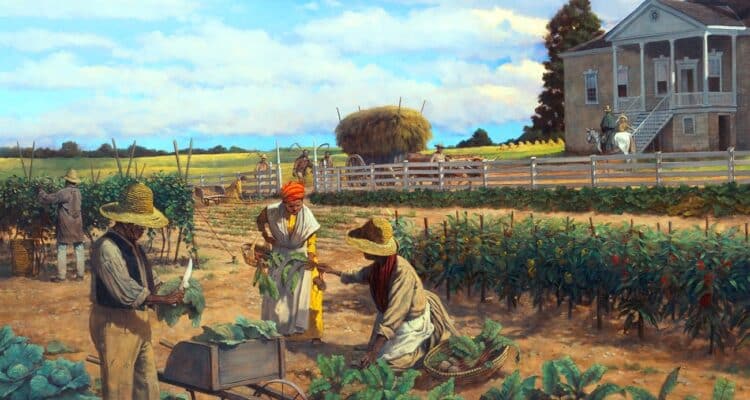Rita Williams-Garcia’s A Sitting in St. James is a powerful and important masterpiece that exposes the depths of self-deception among white plantation owners, shedding light on the roots of racism in America. This page-turner brilliantly weaves a gripping story while addressing the cruelty and startling lack of empathy within some of its characters. Its complexity makes it a perfect book club selection. Read this review to learn more, or check out my video interview with the author here.
Now, let’s dive into the questions that are sure to spark some lively conversations. We included quite a few so you can pick and choose those that suit your group best.
- How does the character of Madame Sylvie Guilbert represent the delusions and self-pity of white plantation owners during this period? How does her treatment of Thisbe reflect this?
- Discuss the complexities of Lucien’s character and his actions in attempting to secure the plantation’s future. How do his decisions impact the enslaved people on the Guilbert plantation?
- Byron’s secret and his need to marry for the plantation’s sake are central to the story. How does this reflect the societal expectations and prejudices of the time? What does it reveal about the character
 s involved?
s involved? - A Sitting in St. James touches on the theme of tradition and the status quo. How do the characters perpetuate harmful traditions, and what are the consequences of their actions?
- Explore the storytelling style of Rita Williams-Garcia. How does she balance a gripping narrative with a deeper exploration of racism and cruelty? What makes this book a potential future classic?
- Did you find the book’s depiction of this historical period challenging to read, and why? What aspects of the story resonated with you the most?
- Consider the book’s title, A Sitting in St. James. How does it relate to the themes and events in the story? What does it signify?
- Discuss the impact of innovative systems for improving plantation yields on the lives of the enslaved people. How does this tie into the broader narrative?
- In what ways does the book encourage readers to reflect on the enduring legacy of racism in America? How can we apply these lessons to contemporary society?
- Would you recommend A Sitting in St. James to others? Why or why not, and who do you think would benefit most from reading this book?
- How does the deep-rooted historical backdrop of the antebellum South shape the inner lives and moral choices of the characters as they navigate through decades of societal transformation?
- In what profound ways do the characters’ racial and social identities sculpt their personal journeys and influence their connections with each other?
- Within the tapestry of heritage and inheritance woven throughout the narrative, what profound lessons about the endurance of familial legacy can we glean from the St. James family’s experiences?
- The story spans generations within the St. James family. How does the wisdom of the elder generation contrast with the aspirations and challenges of the younger generation, and what profound societal shifts are illuminated through this juxtaposition?
- Opal’s introspective diary entries provide a unique window into her thoughts and emotions. How does the interplay of these narrative voices invite us to contemplate the multifaceted nature of the characters and their experiences?
- The St. James mansion itself is a character with a rich history. What symbolic significance can we ascribe to the mansion’s architecture, and how does it symbolize the narrative’s thematic undercurrents?
- The theme of freedom, in its various manifestations, is central to the story. How do characters such as Mary and Della pursue their own interpretations of liberty, and what philosophical insights can we draw from their journeys?
- Secrets, both kept and unveiled, are pivotal to the plot. How do the characters’ choices regarding these secrets prompt us to reflect on the complexity of human relationships and the consequences of silence?
- The evolving relationship between Opal and her granddaughter Mags is a focal point of the narrative. How does their intergenerational connection evolve, and what does it teach us about the intricate dynamics of family bonds?
- Love, loss, and betrayal are profound emotions that course through the narrative. How do these powerful sentiments shape the characters’ destinies and provoke us to ponder the essence of human connection?
- The narrative subtly weaves elements of mysticism and spirituality into the fabric of the story. How do these mystical elements contribute to the overarching mood of the narrative and encourage us to explore the transcendent aspects of the human experience?
- In a world defined by prejudice and social hierarchies, which character embodies resilience and strength in a way that encourages us to reflect on our own capacity for enduring adversity and embracing change?
- The title, A Sitting at St. James, carries layers of meaning. What interpretations can we derive from it, and how does it underscore the narrative’s exploration of identity, place, and history?
- As the story concludes with certain questions unresolved, what contemplations arise regarding the characters’ fates in a world of evolving norms and values, and how do they mirror our own uncertainties about the future?
- Rita Williams-Garcia’s writing style seamlessly melds historical fiction and family drama. How does her craft engage our intellect and emotions, inviting us to partake in a more profound reading experience, and what literary elements left a lasting impact on you?


